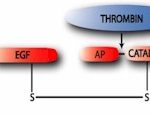DiaPharma Human Protein C Zymogen
$0.00
Domain Structure of Protein C
The domain structure of protein C is represented, where: GLA = region containing γ-carboxyglutamic acid residues, EGF = region containing sequences homologous to human epidermal growth factor, AP = activation peptide released upon conversion of the zymogen to the active serine protease, CATALYTIC DOMAIN = region containing the serine protease catalytic triad. The arrow indicates the site which is proteolytically cleaved by thrombin during activation of the zymogen.
Properties
| Localization: | Plasma | ||||||||
| Plasma concentration: | 4-5 µg/ml (human) 5-10 µg/ml (bovine) |
||||||||
|---|---|---|---|---|---|---|---|---|---|
| Mode of action: | Zymogen; precursor to the serine protease activated protein C (APC) | ||||||||
| Molecular weight: | 62,000 (human) 58,000 (bovine) |
||||||||
| Extinction coefficient: |
|
||||||||
| Isoelectric point: | 4.4-4.8 (human) 4.2-4.5 (bovine) |
||||||||
| Structure: | two chains, Mr=41,000 and 21,000, disulfide linked, NH2-terminal gla domain two EGF domains | ||||||||
| Percent carbohydrate: | 23 % (human) 14 % (bovine) |
||||||||
| Post-translational modifications: | eleven gla residues (bovine), nine gla residues (human), one β-hydroxyaspartate |
Formulation
50% (vol/vol) glycerol/H2O
Purity
>95% by SDS-PAGE
NOT tissue/cell culture grade. Not tested for endotoxin.
Activity
< 0.5% aPC activity by chromogenic assay
Storage & Stability
| Storage | -20°C |
|---|---|
| Shelf Life (Properly Stored) | 12 months |
Sample Gel Info
| Gel | Novex 4-12% Bis-Tris |
|---|---|
| Load | Human Protein C, 1 µg per lane |
| Buffer | MOPS |
| Standard | SeeBluePlus 2; Myosin (191 kDa), Phosphorylase B (97 kDa), BSA (64 kDa), Glutamic Dehydrogenase (51 kDa), Alcohol Dehydrogenase (39 kDa), Carbonic Anhydrase (28 kDa), Myoglobin Red (19 kDa), Lysozyme (14 kDa) |
Background
The vitamin K-dependent zymogen, protein C, is synthesized in the liver as a single chain polypeptide and is subsequently converted to a disulfide linked heterodimer, by removal of a dipeptide (Lys-146 and Arg-147) from the precursor molecule. Trace quantities of the single chain form have been observed in plasma. The light chain, which is responsible for the calcium dependent binding of protein C to phospholipid vesicles, contains 11 γ-carboxyglutamic acid (gla) residues, 1 b-hydroxyaspartic acid residue, and 2 epidermal growth factor (EGF) homology domains. The serine protease catalytic triad is located in the heavy chain. Human protein C is susceptible to proteolytic cleavage of a peptide (Mr=3000) from the COOH-terminal end of the heavy chain, yielding an altered form referred to as β-protein C. No functional distinction between α- and β-protein C has been observed. A single cleavage at Arg-12 (Arg-14 in bovine) of the heavy chain of human protein C converts the zymogen into the serine protease, activated protein C. This cleavage is catalyzed by a complex between α-thrombin and the endothelial cell surface protein thrombomodulin. In contrast to the other vitamin K dependent coagulation factors, activated protein C functions as an anticoagulant by catalyzing the proteolytic inactivation of factors Va and VIIIa. APC also contributes to the fibrinolytic response by complex formation with plasminogen activator inhibitors.
Bovine protein C is prepared from fresh citrated bovine plasma by a modification of the Walker procedure, as described by Haley et al. Human protein C is prepared from fresh frozen citrated human plasma using a combination of immunoaffinity chromatography, and conventional techniques. Protein C is provided in 50% (vol/vol) glycerol/H2O and should be stored at -20°C. Purity is determined by SDS-PAGE analysis and activity is measured using a chromogenic substrate based assay.

